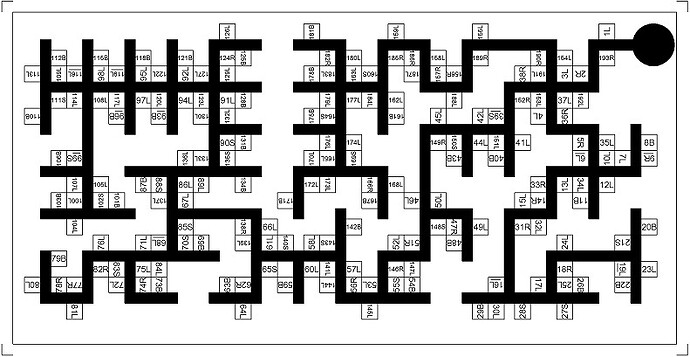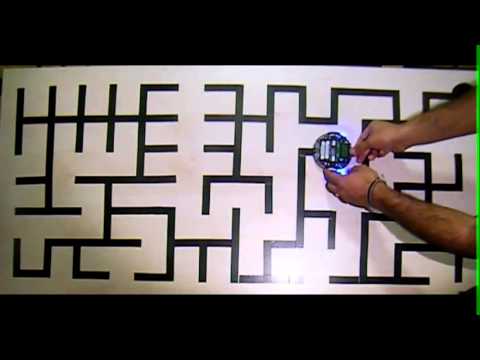Hello,
Well here is the code, the modifications are only on the maze-solve.c class, the maze shown on the video has 71 steps.
the main Idea was to record the turns and the intersection type, I wrote some comments about it on the code, then when we start the robot from any point it will run for some steps to decide its location, then we simplify the rest of the path to the end, then the robot follows the simplified path!
The Code:
/*
* This file contains the maze-solving strategy.
* Modified By Moat Amer 04Jan2013
* moatasa@gmail.com
*/
#include <pololu/3pi.h>
#include "follow-segment.h"
#include "turn.h"
// The path variable will store the path that the robot has taken. It
// is stored as an array of characters, each of which represents the
// turn that should be made at one intersection in the sequence:
// 'L' for left
// 'R' for right
// 'S' for straight (going straight through an intersection)
// 'B' for back (U-turn)
//
// Whenever the robot makes a U-turn, the path can be simplified by
// removing the dead end. The follow_next_turn() function checks for
// this case every time it makes a turn, and it simplifies the path
// appropriately.
char path[100] = "";
int intersection[100];
unsigned char path_length = 0; // the length of the path
char paths[10] = "";
int intersections[10];
unsigned char paths_length = 0; // the length of the path sample
int m=5;
char pathsol[100] = "";
unsigned char pathsol_length = 0; // the length of the pathsol
// This function decides which way to turn during the learning phase of
// maze solving. It uses the variables found_left, found_straight, and
// found_right, which indicate whether there is an exit in each of the
// three directions, applying the "left hand on the wall" strategy.
char select_turn(unsigned char found_left, unsigned char found_straight, unsigned char found_right)
{
// Make a decision about how to turn. The following code
// implements a left-hand-on-the-wall strategy, where we always
// turn as far to the left as possible.
if(found_left) // L->1
return 'L';
else if(found_straight) // S->2
return 'S';
else if(found_right) // R->3
return 'R';
else // back->0
return 'B';
}
// code for intersection recording
int record_intersec(unsigned char found_left, unsigned char found_straight, unsigned char found_right)
{
// Make a decision about how to turn. The following code
// implements a left-hand-on-the-wall strategy, where we always
// turn as far to the left as possible.
if(found_left && found_right && found_straight) // LRS->4
return '4';
else if(found_left && found_right) // LR->3
return '3';
else if(found_right && found_straight) // RS->2
return '2';
else if(found_left && found_straight) // LS->1
return '1';
else // No intersection->0
return '0';
}
// Path simplification. The strategy is that whenever we encounter a
// sequence xBx, we can simplify it by cutting out the dead end. For
// example, LBL -> S, because a single S bypasses the dead end
// represented by LBL.
void simplify_path()
{
// only simplify the path if the second-to-last turn was a 'B'
if(pathsol_length < 3 || pathsol[pathsol_length-2] != 'B')
return;
int total_angle = 0;
int i;
for(i=1;i<=3;i++)
{
switch(pathsol[pathsol_length-i])
{
case 'R':
total_angle += 90;
break;
case 'L':
total_angle += 270;
break;
case 'B':
total_angle += 180;
break;
}
}
// Get the angle as a number between 0 and 360 degrees.
total_angle = total_angle % 360;
// Replace all of those turns with a single one.
switch(total_angle)
{
case 0:
pathsol[pathsol_length - 3] = 'S';
break;
case 90:
pathsol[pathsol_length - 3] = 'R';
break;
case 180:
pathsol[pathsol_length - 3] = 'B';
break;
case 270:
pathsol[pathsol_length - 3] = 'L';
break;
}
// The path is now two steps shorter.
pathsol_length -= 2;
}
// This function is called once, from main.c.
void maze_solve()
{
// Loop until we have record the maze.
while(1)
{
// FIRST MAIN LOOP BODY
follow_segment();
// Drive straight a bit. This helps us in case we entered the
// intersection at an angle.
// Note that we are slowing down - this prevents the robot
// from tipping forward too much.
set_motors(50,50);
delay_ms(50);
// These variables record whether the robot has seen a line to the
// left, straight ahead, and right, while examining the current
// intersection.
unsigned char found_left=0;
unsigned char found_straight=0;
unsigned char found_right=0;
// Now read the sensors and check the intersection type.
unsigned int sensors[5];
read_line(sensors,IR_EMITTERS_ON);
// Check for left and right exits.
if(sensors[0] > 100)
found_left = 1;
if(sensors[4] > 100)
found_right = 1;
// Drive straight a bit more - this is enough to line up our
// wheels with the intersection.
set_motors(40,40);
delay_ms(200);
// Check for a straight exit.
read_line(sensors,IR_EMITTERS_ON);
if(sensors[1] > 200 || sensors[2] > 200 || sensors[3] > 200)
found_straight = 1;
// Check for the ending spot.
// If all three middle sensors are on dark black, we have
// solved the maze.
if(sensors[1] > 600 && sensors[2] > 600 && sensors[3] > 600)
break;
// Intersection identification is complete.
// If the maze has been solved, we can follow the existing
// path. Otherwise, we need to learn the solution.
unsigned char dir = select_turn(found_left, found_straight, found_right);
int recint = record_intersec(found_left, found_straight, found_right);
// Make the turn indicated by the path.
turn(dir);
// Store the intersection in the path variable.
path[path_length] = dir;
intersection[path_length] = recint;
path_length ++;
// You should check to make sure that the path_length does not
// exceed the bounds of the array. We'll ignore that in this
// example.
}
// Maze Recorded!
while(1)
{
// Beep to show that we finished the maze.
paths_length=0;
set_motors(0,0);
play(">>a32");
// Wait for the user to press a button.
while(!button_is_pressed(BUTTON_B))
{
clear();
print("Recorded!");
lcd_goto_xy(0,1);
print("Press B");
delay_ms(30);
}
while(button_is_pressed(BUTTON_B));
clear();
print("Here we");
lcd_goto_xy(0,1);
print("Go!");
delay_ms(1000);
int i=0;
while (i<4)
{
follow_segment();
// Drive straight a bit. This helps us in case we entered the
// intersection at an angle.
// Note that we are slowing down - this prevents the robot
// from tipping forward too much.
set_motors(50,50);
delay_ms(50);
// These variables record whether the robot has seen a line to the
// left, straight ahead, and right, while examining the current
// intersection.
unsigned char found_left=0;
unsigned char found_straight=0;
unsigned char found_right=0;
// Now read the sensors and check the intersection type.
unsigned int sensors[5];
read_line(sensors,IR_EMITTERS_ON);
// Check for left and right exits.
if(sensors[0] > 100)
found_left = 1;
if(sensors[4] > 100)
found_right = 1;
// Drive straight a bit more - this is enough to line up our
// wheels with the intersection.
set_motors(40,40);
delay_ms(200);
// Check for a straight exit.
read_line(sensors,IR_EMITTERS_ON);
if(sensors[1] > 200 || sensors[2] > 200 || sensors[3] > 200)
found_straight = 1;
unsigned char dir = select_turn(found_left, found_straight, found_right);
int recint = record_intersec(found_left, found_straight, found_right);
// Make the turn indicated by the path.
turn(dir);
// Store the intersection in the path variable.
paths[paths_length] = dir;
intersections[paths_length] = recint;
if (paths[paths_length] != 'B')
{
i++;
paths_length ++;
}
else
{
paths_length ++;
}
}
// Find the robot location with respect to the end.
// The Robot location code can be simplified more.
// Its Possible to modify this code, so we start by running the robot two steps,
// then we check how many values of m we have, if we have more than one value we add another step and so on until we have one m value.
int i2;
int c2;
for (i=0;i<100;i++)
{
if (i<(100-paths_length))
{
i2=0;
while (i2<paths_length)
{
c2=0;
if (paths[i2]==path[i+i2] && intersections[i2]==intersection[i+i2])
{
c2=1;
i2++;
}
if (c2!=1)
{
i2=100;
}
if (i2 == paths_length )
{
m=i+paths_length;
}
}
}
}
// We found the Robot location, now find the shortest way to the end.
for(i=0;i<(100-m);i++)
{
pathsol[pathsol_length]=path[i+m];
pathsol_length ++;
simplify_path();
}
// Go to the end.
i=0;
while(i<pathsol_length)
{
// Re-run the maze. It's not necessary to identify the
// intersections, so this loop is really simple.
follow_segment();
// Drive straight while slowing down, as before.
set_motors(50,50);
delay_ms(50);
set_motors(40,40);
delay_ms(200);
// Make a turn according to the instruction stored in
// pathsol[i].
turn(pathsol[i]);
i+=1;
unsigned int sensors[5];
read_line(sensors,IR_EMITTERS_ON);
// The end is reached.
if(sensors[1] > 600 && sensors[2] > 600 && sensors[3] > 600)
pathsol_length=0;
}
// Now we should be at the finish! Restart the loop.
}
}
// Local Variables: **
// mode: C **
// c-basic-offset: 4 **
// tab-width: 4 **
// indent-tabs-mode: t **
// end: **
Moat.











